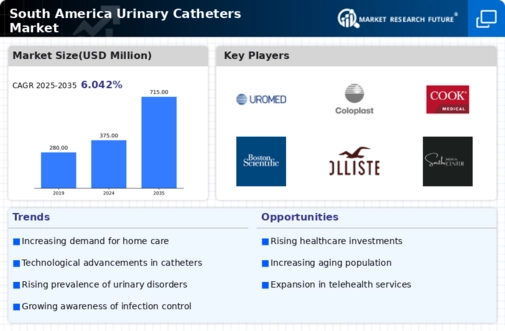The South America Urinary Catheters Market is characterized by a diverse set of players, ranging from well-established multinational corporations to emerging local firms. Each is vying for market share in a projected landscape marked by growing healthcare needs and increasing awareness regarding urinary health.
The competitiveness of this market is primarily driven by the advancements in catheter technology, improved materials that enhance patient comfort, and the rise in surgical procedures, which consequently elevate the demand for urinary catheters.
Innovation in product development, strategic partnerships, and distribution agreements are crucial approaches adopted by companies operating in this sector to strengthen their footprint across various South American countries. Additionally, service quality, regulatory compliance, and cost-effectiveness further influence competitive dynamics, underscoring the heightened emphasis on providing superior healthcare solutions tailored to the specific needs of patients and healthcare providers in the region.
B. Braun Melsungen stands out as a formidable player in the South America Urinary Catheters Market, renowned for its commitment to quality and patient safety. The company's strength lies in its broad portfolio of high-quality urinary catheter products designed for diverse clinical needs, ensuring a strong presence in hospitals and clinics across the region.
B. Braun Melsungen is known for its innovative solutions that include not only traditional catheters but also advanced options that minimize infection risks and improve patient comfort. Its strong distribution network and partnerships with local healthcare institutions enable the company to maintain a competitive advantage.
Furthermore, the emphasis on research and development allows B. Braun Melsungen to consistently introduce new products tailored to the South American market, reinforcing its position as a market leader focused on addressing the evolving demands of healthcare professionals and patients alike.
UroMed also plays a significant role in shaping the South America Urinary Catheters Market, providing a range of specialized catheter products designed specifically to address the unique needs of patients suffering from urinary incontinence and related conditions.
The company is recognized for its dedication to customer support and personalized solutions, which enhance its reputation among healthcare providers. UroMed's product offerings include advanced intermittent catheters and innovative drainage solutions, allowing it to cater to various patient demographics, including children and elderly populations with special requirements.
The company's strategic approach includes fostering partnerships with local distributors and healthcare facilities to enhance market penetration. While aware of the competitive pressures in the region, UroMed aims to expand its market presence through targeted marketing campaigns and potential mergers or collaborations that could strengthen its product lineup and distribution capabilities.
Through these efforts, UroMed seeks to solidify its position as an essential player within the South America Urinary Catheters Market, highlighting its commitment to improving the quality of life for patients in need of urinary care solutions.




















Leave a Comment